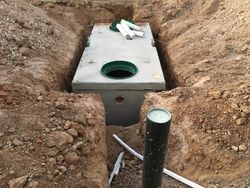
Home septic systems are remarkable simple water treatment systems that rely on the natural filtration properties of the soil. While they only require minimal maintenance, clogs, and other damage can cause potentially serious issues that could result in sewage spills and backed-up pipes. If you’re planning a septic installation, knowing how the system works can help avoid problems and keep wastewater flowing smoothly.
3 Main Components of a Septic System
1. The Septic Tank
After it goes down the drain, wastewater drains into a large plastic or concrete tank buried under the lawn. The septic tank’s primary purpose is to separate solid waste, which sinks to the bottom, from liquid wastewater. While fluid drains out into the rest of the system, the sludge at the bottom of the tank needs to be pumped out, usually every two to three years.
2. Distribution Box
 Liquid waste then flows into the distribution box, which is normally placed slightly downhill. This box is fitted with rotating flow leveling devices that ensure wastewater flows evenly into the drainfield. Without it, some areas of the soil would become saturated with wastewater while others remain dry.
Liquid waste then flows into the distribution box, which is normally placed slightly downhill. This box is fitted with rotating flow leveling devices that ensure wastewater flows evenly into the drainfield. Without it, some areas of the soil would become saturated with wastewater while others remain dry.
3. The Drainfield
The drainfield, or leach field, is the final part of a septic installation. A network of perforated pipes underground allows wastewater to slowly drain into the soil, which naturally filters out contaminants.
While foreign objects can clog drainfield pipes, most issues are caused by parking or driving vehicles across the surface. Crushed or damaged pipes may cause water to flow back into the septic tank or flow directly into the soil.
As a leading septic installation provider in Phoenix, AZ, J-King Excavating has the expertise and equipment to handle every step of the process. Their team provides extensive service afterward, with the expertise to keep your system running smoothly for years to come. Visit their website for more on their septic installation services or call (623) 377-3858 to request an estimate.
About the Business
Have a question? Ask the experts!
Send your question

